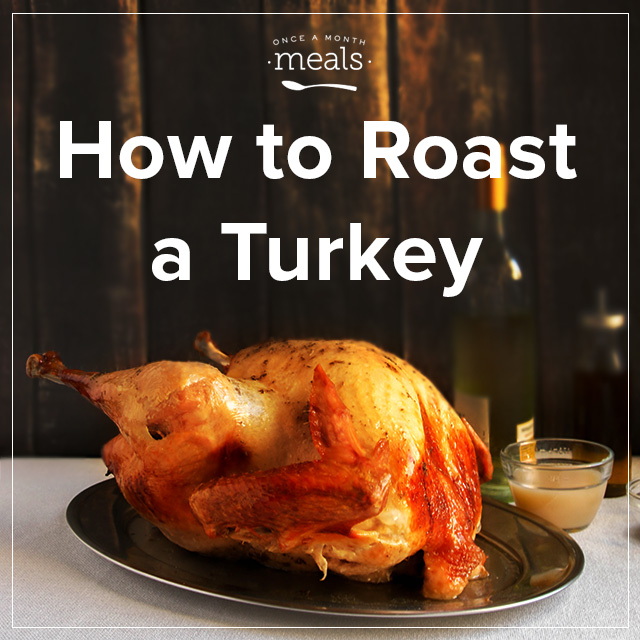
When my husband and I moved to North Dakota five years ago, we suddenly found ourselves celebrating our first Thanksgiving without our families nearby, and I was determined to figure out how to roast a turkey and start a new tradition. When I was growing up, my family always ordered a smoked turkey from a local restaurant, so I had zero instruction on preparing a turkey the “old fashioned” way!
I poured over several food websites and recipes and finally decided that I’d make Tyler Florence’s oven-roasted turkey with sage butter. It was good, but over the past five years, I’ve sort of combined elements of that recipe with some other elements of my own to create an amazing roasted turkey–great for Thanksgiving, Christmas, or any other special occasion–that beats out a store-bought smoked turkey any day!
Don’t panic! The Once a Month Meals team is here to walk you through how to roast a turkey for any holiday gathering.
Don’t be intimidated or influenced by what you hear from everyone else (turkeys must be brined, oven-roasted turkey is dry, etc.), or be afraid to try it out if you’re a first-timer. Jump right in and have fun! There’s really no one perfect way to roast a turkey, but there are plenty of “wrong” turns to be made if you’re not sure what you’re doing. So we’re here to help you through the basic steps.

5 Simple Steps for Preparing Your Bird for the Big Day:
1. Select your turkey.
Head to the grocery store or wherever it is you purchase your meat.
If you purchase a frozen turkey, start thawing it in the refrigerator AT LEAST 3 days before you plan to cook it, if not longer for larger turkeys.
➡ You can use the thaw time calculator here to help gauge when to start thawing based on your turkey’s weight.
*REMINDER: Please do not thaw your turkey at room temperature on your countertop, as this can result in the growth of bacteria. I don’t want you or your guests to get sick!
2. Prep the bird.
Make sure your kitchen sink is empty and clean and place the turkey, wrapper, and all into the sink.
Remove the wrapper and discard, then remove the giblet packet and the gizzards from the turkey cavity. There’s usually one packet in the “front cavity” and one in the back. If you don’t plan to use these (I never do) they may be discarded. *If you are feeling a little adventurous, though, you can make a stock or gravy from them!
Next, rinse the turkey thoroughly with lukewarm water. (Yes, your hands are going to get icky with turkey slime if they haven’t already.) Make sure the cavities get rinsed and drained as well.
Pat the turkey dry with paper towels, then place in your roasting pan.
3. Add seasoning under the skin.
Brush the turkey with olive oil, then generously rub kosher salt all over the turkey, inside and out. (Yes, don’t be timid. Salting it ahead of time helps it work into the turkey!) You may also use any other seasonings you like. I normally go pretty heavy with black pepper and garlic powder.
Next, take about 2-3 sticks of softened butter, and “smoosh” them under the skin, between the skin and the breast meat, on the top side of the turkey.
If you want a unique turkey that isn’t run-of-the-mill, take some pomegranate molasses (found at specialty or international foods stores) and glaze the turkey with that before it goes in the oven.
4. Bake the turkey.
If you have a meat thermometer, now is the time to place it on the thickest part of the turkey, around the thigh, going as deep as possible without touching the bone.
Bake at 325°F for about 12-15 minutes per pound.
There are tons of turkey cooking guidelines out there (as well as the wrapper your turkey came in) and they are all pretty reliable. The important thing is making sure your turkey gets to an internal temperature of 165°F.
Now, the key to having a moist and delicious turkey is to baste. It gets to be a pain, but basting with a mixture of melted butter and honey (you can use this or broth, or just about anything!) every 10-15 minutes works wonders. Once the top of the turkey (breast area) gets nice and golden brown, you’ll want to put a foil tent over it to protect it from over-cooking. If you hate basting and you are ok with cooking in plastic, you can try using an oven bag.
5. Let it REST!
This is important! So don’t skip this step even if you’re hungry and ready to dig in.
Once your turkey has reached 165°F, remove it from the oven and let it rest at least 30 minutes. Carve, and place the carved turkey pieces back into the drippings before serving. This will keep the meat super moist and flavorful.
You can even cook the turkey the night before, carve it, and store it overnight in the refrigerator in the drippings, then heat everything up in the oven the next day.
Hint: You can cook it well in advance and freeze it too! But you knew that we were going to say that, right?
Bonus Tip: Use it up!
The deliciousness doesn’t have to end there, though. After eating your fill and setting aside any extra meat for leftover recipes, hang onto the carcass and scraps to make homemade stock for some scrumptious winter soups.
You can adapt this recipe for homemade chicken broth. Simply substitute turkey bones for chicken bones. You can use the stock right away in your post-Thanksgiving recipes or store in freezer-safe containers and freeze to enjoy another day.
